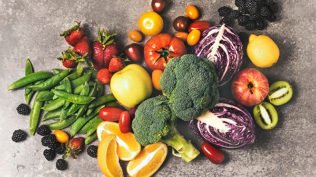Contaminated food can cause serious illness for people with compromised immune systems.
Apples and cantaloupe, lettuce and zucchini – fruits and vegetables from A to Z have all been recalled in recent years for contamination. We’re not talking simply about dirt. We’re talking about pathogens that could make you sick and even be deadly.
But awareness and careful food preparation can help protect your family’s health.
WHAT IS A PATHOGEN?
A pathogen is one of five types of microorganism that can cause disease: bacteria, fungi, parasites, protozoans and viruses.
The most common types of bacteria and viruses found on produce are:
- E. coli
- Listeria monocytogenes
- Salmonella
- Shigella
- Hepatitis A
- Norovirus
OLD GERMS, NEW DANGERS
Many pathogens have become more deadly as a result of new strain mutations. For example, E. coli 0157:H7 can be life-threatening. Listeria, once found only on certain types of foods, is now on many kinds of food products, including produce. What’s worse, listeria contamination does not exhibit symptoms until 30 to 90 days following ingestion. It can be deadly to children, elders or anyone with a compromised immune system. Salmonella, once a cause of uncomfortable gastrointestinal upset, includes current strains that can be deadly.
Pathogens are not natural to produce. Contamination can occur on the farm from:
- Tainted water or equipment
- Poor hygiene by workers
- Lack of sanitary conditions
- Animals raised on adjacent farms
As part of its effort to prevent serious illness, the Food and Drug Administration has a new Produce Safety Rule for farms, setting standards for:
- Water quality
- Testing
- Soil amendments (manure and compost)
- Sprouts
- Domesticated and wild animals
- Worker training
- Health and hygiene
- Equipment, tools and buildings
WASH FIRST, CUT LATER
Fortunately, most pathogens do not penetrate produce readily and usually can be removed with a thorough washing while working in a clean preparation area. A cardinal rule of produce safety is “wash first and cut later.” Slicing unwashed produce or using a contaminated knife, blade or cutting board can cause a pathogen to penetrate the produce.
While consumers enjoy produce, we must not forget that some pathogens that can be found on produce are deadly. Thorough washing can allow us to continue to enjoy healthy produce.
MORE INFORMATION
U.S. Government website for Food Recalls and Alerts
FSMA Final Rule on Produce Safety
USDA Guide to Washing Fresh Produce, with the Colorado State University Extension Service
Centers for Disease Control and Prevention Fruit and Vegetable Safety
This loss control information is advisory only. The author assumes no responsibility for management or control of loss control activities. Not all exposures are identified in this article. Contact Landmark Risk Management & Insurance for coverage advice and policy service.

